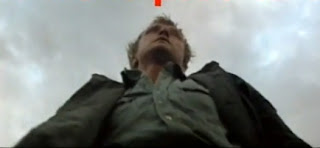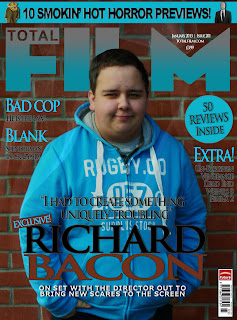Question
1: In what ways does your media product (trailer) use, develop or challenge
forms and conventions of real life products?
Horror Conventions
Genres have
different conventions which set them apart from one another. This was the idea
felt by Thomas Schatz who expressed in his book Hollywood Genres (1981) that
the best way to analyse films was through the genre. Each and every genre has
“genre fans” which help give the director some ideas of how to sell the film to
them. When you go see a certain type of film you expect to see certain things. Genres can change within limits so it keeps
enough variety to maintain interest and have new ideas that could appeal to the
fans of the genre. But enough repetition is essential to make sure the audience
enjoy the film because of the genre.
When making
my own horror trailer I had to understand the conventions of the horror genre,
so I could deliver something that would be expected from a horror film. While
also making sure I had my own ideas so the film would stand alone.
For example,
we include the stereotypical ‘creepy’, isolated location in our film. We set Harvest
on Crepsley Hill in an abounded farmer’s field. We felt this location would
offer something expected from horror, as it stands alone with nothing much
around it, giving that real sense of isolation. Yet it also gave some
innovation, not many films are set in a large open space. But we thought it
would be interesting to allow the characters space to run, yet giving them
nowhere really to run too. This is very similar to the 2011 film Husk, in which “A group of friends
stranded near a desolate cornfield find shelter in an old farmhouse”.
Collision
cutting was another convention we put in Harvest on Crepsley Hill. This
is when you put two juxtaposition elements together to make them seem more
extreme. In our trailer we go from fast-quiet-loud. These three states next to
one another make them seem far more over the top than they actual are. This
helps to deliver the ‘jump scare’ in our trailer, when we have an extreme close
up and a scream. This is similar to Texas
Chainsaw Massacre trailer in which it goes quite for a few seconds, and
then a chainsaw slams through a door.
Our “Psycho
serial killer” is very much based around Mike Myers, the killer from Halloween. We were fascinated by the way
he stalked his victims. Also, the way he casual strolls around as he kills
people was something we took from him. In our trailer, Ryan is chasing me and
while I’m frantically running away, he walks around with such ease. We wanted
to create the archetype of the slow moving monster/serial killer, which tells
the audience, what he is doing doesn’t affect him.
P.O.V shots were another typical horror convention we put in our trailer to establish emotional attachment between the audience and the characters on screen. When the Scarecrow (Ryan) is standing over Richard we see it through the eyes of him (Richard) to show how they should feel weak and intimidated by the Scarecrow. This is very similar to Psycho, in the famous shower scene we see the killer through the eyes of Marion. This is used to make us feel like we are about to go through the experience first-hand.
We explored
the theme of being trapped and lonely with our trailer The teenagers are, of
course, isolated but so is the killer Ryan before he turns into the Scarecrow His
isolation has driven him insane. This is very similar to Pamela Voorhees, the
killer from the original Friday the 13th.
She is seeking revenge for the death of her child Jason. We felt it would a
good idea to represent a killer that actual has some form of a motive, rather
than a mindless killing machine.
Trailer Conventions
The same as
the genre, trailers have certain conventions that you must stick by when making
them. For instance, you cannot make a film trailer which looks like one genre
of film, but then turn out to be nothing like that. For example 2009’s Drag Me To Hell looked to be the next
big horror film, the trailer was terrifying. The final product wasn’t so horrifying
and was often more of a comedy film and this got people angry. You have to
deliver on what you advertise.
Most trailers
have the same format of a slow build up to a fast finish; and the same can be
said about our trailer. Making the trailer one giant collision cut makes both
elements of the trailer more extreme. The slow build up allows us to build some
narrative, while the final 30 seconds are pure action which excites the viewer
while cross cutting to the inter-titles and the film’s title. This is known as
a highlight trailer. Where, rather than showing you one section of the film
(scene trailer) we tease the story, and some of the ‘wow’ moments of the film,
without spoiling the narrative. This is
very similar to the trailer for George A. Romero Land of the Dead. This trailer starts slow, building the story. It
then kicks in to show some moments of excitement and tells the viewer what they
can expect from the film.
The use of
inter-titles within trailers help to explain the story, and this is no
different to ours. The use of inter-titles allows us to not use painful obvious
dialogue and scenes to explain the story, and if anything helps to established
the narrative better. Inter-titles in our trailer help to establish the
“transformation” that Ryan goes through to become the murderous scarecrow. An
excellent example of well used inter-titles is the Evil Dead (2013) trailer, in which inter-titles explains to people
new to the series the basic premise of the story.
This is an “appropriate
audience” action horror trailer; it hasn’t got great moments of ‘body horror’ it
still shows a lot of horror moments, and deals with subjects that wouldn’t be
comfortable with a younger audience. The trailer is 15 rated for an 18
certificate film. It’s very similar to the Dawn
of the Dead (2003) trailer which was classified as a 15, while the film was
a strong 18 rating. With the easing on censorship, we have be able to make this
film to appeal to a teenage audience while also pulling in the older
demographic. Of horror fans
The Influence of Auteurs
When trying
to bring my own soul to the film I brought what scared me the most in horror
films: collision cuttings and jump scares. I feel that these are the most
effective way to scare the audience as their in nothing you can do about it,
the ability to draw out a scare so the audience are also begging for it just to
happen. That is why we created the post title screen shot where the Scarecrow
comes towards the camera in extreme close up and screams.
Zack Snyder
was the biggest auteur influence on our trailer. He was the director for Dawn
of the Dead and Watchmen. Both these films are examples of how
Snyder uses a mix of slow and quick montage with violence in his films,
something that we tried to re-create in our trailer. Also, both these film were
huge successes at the Box office pulling in a lot of profit. We feel that Harvest
on Crepsley Hill could emulate that success.
Action
horrors are currently doing very well with the audience, as proved by the
success of the latest Resident Evil film. The problem is audiences aren’t
looking to be intellectually challenged when they go see a film, they want to
be entertained and excited. From this we knew we needed a solid but basic
story, but also to have a lot of action so they don’t become bored with the
film. This is why in the trailer we have 3 death scenes, to show the audience
we are as much about actions as story.




























